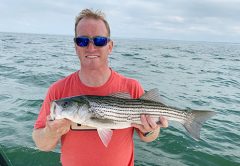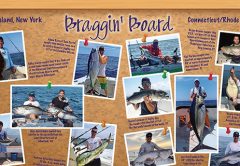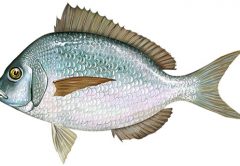Drifting along the east span of Robert Moses Bridge, I could feel the wind beginning to make up with the change of tide. It had been a relatively quiet night, but the influx of cool, incoming water was now bringing life to a stretch of water immediately adjacent to the shadow line that paralleled the bridge. At first, there were light, gentle splashes, then a few deeper sounding slaps. In the distance, perhaps two stanchions closer to the beach, I heard a cow bass inhale some poor baitfish from the surface with a loud and definitive slurp.

The last sound caused me to reposition and within a minute or two I was drifting through the area with a live eel wiggling at the end of my line. Sure enough, the strike came and, in short order, a beautiful 30-pound linesiders was staring up at me from tight to the port side.
EELS REIGN SUPREME
If you haven’t given live eels a try for stripers, now is the time to take the plunge. As the waters continue to warm over the next few weeks, the hot bite on soft plastics will likely
dwindle to a pick and live bait will be needed to keep the linesiders interested on a regular basis. While it is always possible to connect with lures, using live eels late at night is the usually the surest way to hook up with a summer bass weighing 20 to 30 pounds or more. In short, from Independence Day though the early fall, eels reign supreme.

Gearing up for eelin’ is pretty basic. The main point to consider is that you are looking for big fish when using these baits so leave the light spinning setups at home. Striper experts generally choose beefy conventional setups with 30-to 40-pound test lines and stiff rods measuring six to seven-and-a-half feet long. Braided lines work well for this kind of fishing, especially if you will be targeting bass in the fast-moving water of Jones, Fire Island, Moriches or Shinnecock inlets, but monofilament lines will suffice under most conditions.
For rigs, there are two primary choices that can be used just about anywhere: drail rigs and three-way rigs. The drail rig consists of a two-to six-ounce drail tied to one end of a five-foot length of 40-to 60-pound-test mono leader. The hook, a 4/0 to 8/0 Gamagatsu live bait hook or similar model, is tied to the opposite end of the leader. The three-way rig, which is also popular off Montauk and Orient points, consists of a four-to 10-ounce bank sinker connected to the bottom loop of a three-way swivel via a two-foot length of 30-pound test line. To the middle loop of the three-way tie a five-to six-foot length of 60-pound-test mono and attach the hook. The top loop of the three-way swivel is then tied to the main line. Use the drail rig in areas of gentle current or shallow water. Use the three-way rig where currents run strong or the bass hold deep.
With either setup, the idea is to keep the bait two to three feet above the bottom at all times.
KEEP THE EELS FRESH
Some anglers catch their own eels, but it is easier to simply buy them from your local tackle shop where they should run about $2.00 each. Expect to need six to eight eels per angler for half a tide of fishing, although you may need more if big bluefish are present or the bass bite is red hot. Once you buy the eels, keeping them alive until you can get them in front of a hungry bass is primary task. The key to success with this task is to keep the eels cool. Place a few inches of ice on the bottom of a five-gallon pail – don’t place the eels in a live well or you’ll never get them out – and put a piece of burlap or a thick rag over the cubes. Now, dump up to two-dozen eels over the rag. It might take a few minutes, but the ice will chill the eels, slowing them down to a lethargic speed and making them easier to handle and hook.

To place a live eel on a hook, use a rag to grasp it right behind the head. While holding the snake tight, bring the point of your hook up through the lower jaw and out one of the eye sockets. Whichever eye socket you choose, the eel should drift behind the boat slightly to that side. Thus, if you are fishing side-by-side with another angler, one eel should be hooked out
the left side socket, the other out the right side socket so the two eels will drift as far apart as possible. Bring the hook through the snout, between the nostrils, if you want the eel to drift straight. As soon as you lower your chilled eel into the water, the warming effect will reduce the lethargy, bringing the eel back to a feisty, fish- attracting state.
BLUES LOVE EELS, TOO
In a perfect world, stripers would be the only fish that eat eels, but you know how that goes. Aside from bass, big blues love the slimy snakes. The problem is they chomp them in half. That can make fishing with this bait a costly proposition at times. Thus, save your eels for the best tides and prime locations, and try moving to another spot if the blues invade the area and make it impossible to keep a whole live bait in the water for more than a minute or two.
In the glass half-full department, big blues put up quite a battle and can be fun to catch, and half-eels left over from a pass through the chopper schools can always be filleted to make great strip baits for ocean fluke.
The bass are here and still hitting soft plastic swimming shads, Fin-S-Fish and Slug-Goes with abandon inside all of the South Shore inlets. Soon, however, the warming water will take its toll and the bigger bass will become harder to tempt with imitations. As you feel the spirit of spring begin to fade from the local linesiders, make the switch to fishing night tides and using live eels for bait. You just might find that there are still plenty of big fish to be found even during the hottest and busiest of the summer months.
[easy-social-share]









